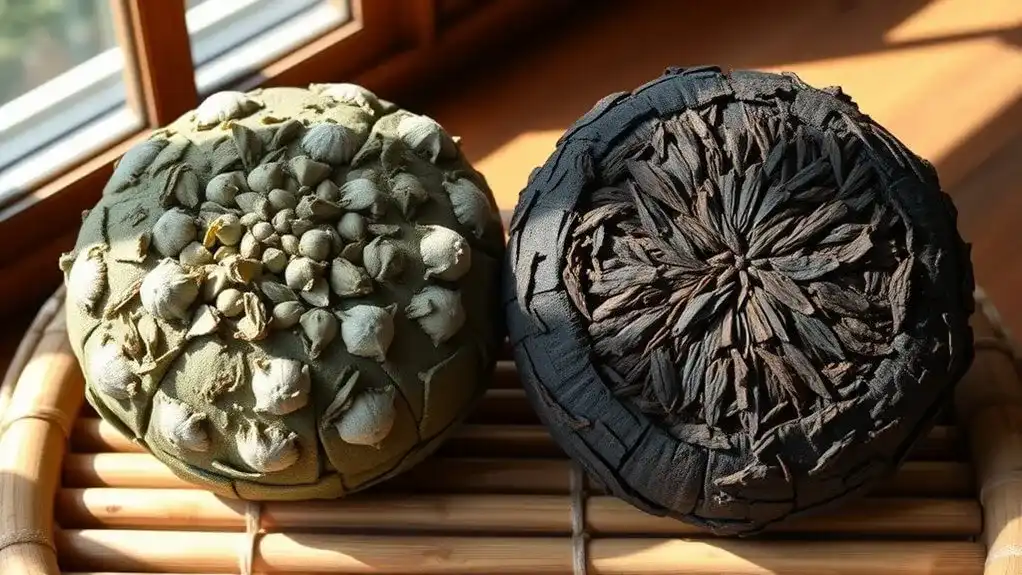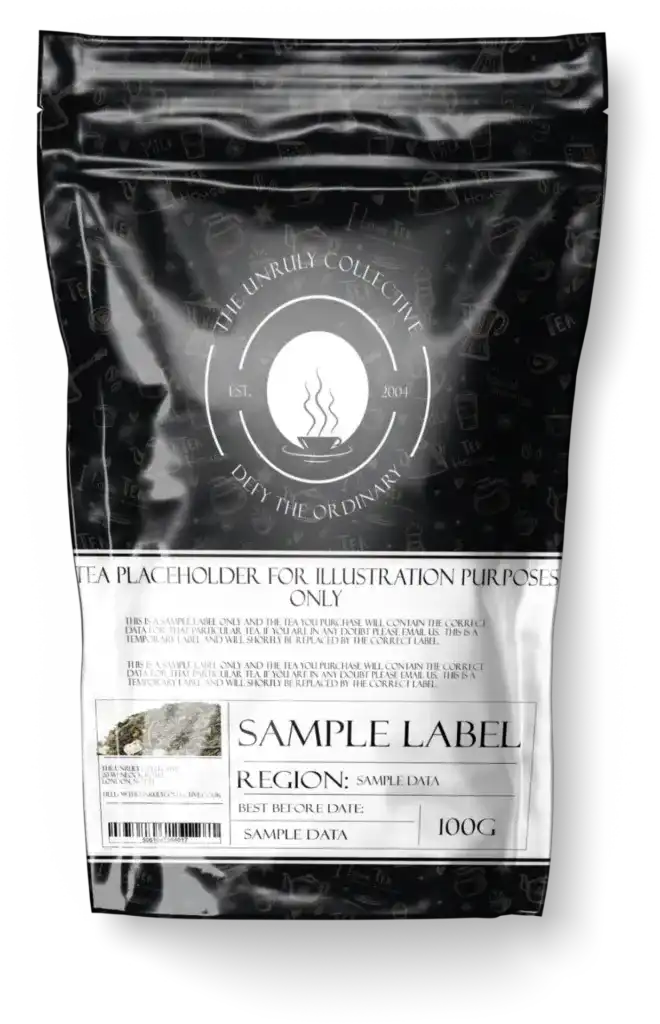Raw and ripe Pu-erh teas differ markedly in their processing methods and flavor profiles. Raw Pu-erh undergoes natural aging after initial processing, developing complex bitter-sweet notes over time. In contrast, ripe Pu-erh uses a controlled fermentation process called wo dui, creating deeper, earthier flavors in just weeks. While raw Pu-erh can age for decades, ripe Pu-erh offers immediate rich characteristics. The distinct processing approaches behind these two varieties reveal fascinating nuances in taste and aging potential.
Key Points
- Raw Pu-erh ages naturally over time, while ripe Pu-erh undergoes artificial fermentation through wet-piling to accelerate the aging process.
- Raw Pu-erh maintains higher enzyme levels and develops sharper initial tastes, whereas ripe Pu-erh features deeper, earthier flavors.
- The wet-piling process for ripe Pu-erh takes 15-40 days in controlled warm, humid conditions to achieve its characteristic dark color.
- Raw Pu-erh appears lighter in color and can age for decades, while ripe Pu-erh shows darker hues and greater flavor stability.
- Both varieties start as mao cha, but ripe Pu-erh undergoes additional fermentation developed by the Menghai tea factory in the 1970s.
The Basic Production Steps of Raw Pu-erh

The production of raw Pu-erh tea follows a meticulous four-step process that begins in the early morning hours. The picking techniques start shortly after sunrise, when the leaves' water content is ideal, and this initial phase typically concludes between 10 AM and noon. The fresh leaves must be properly prepared through initial drying to inactivate enzymes. This traditional process yields tea that can be pressed into cakes for aging and development of complex flavors.
After harvesting, withering methods involve placing the fresh leaves on drying tables for one to two days, allowing them to breathe and lose excess moisture. The tea then undergoes "sha qing," either by machine for three minutes or through manual pan-frying, to reduce fermentation. This process helps soften the leaves for the subsequent steps. The process concludes with rolling, which breaks down the leaves to release their full potential, followed by a three-day sun-drying period. This final stage produces mao cha, the base material for both green and black Pu-erh varieties.
The Unique Process Behind Ripe Pu-erh
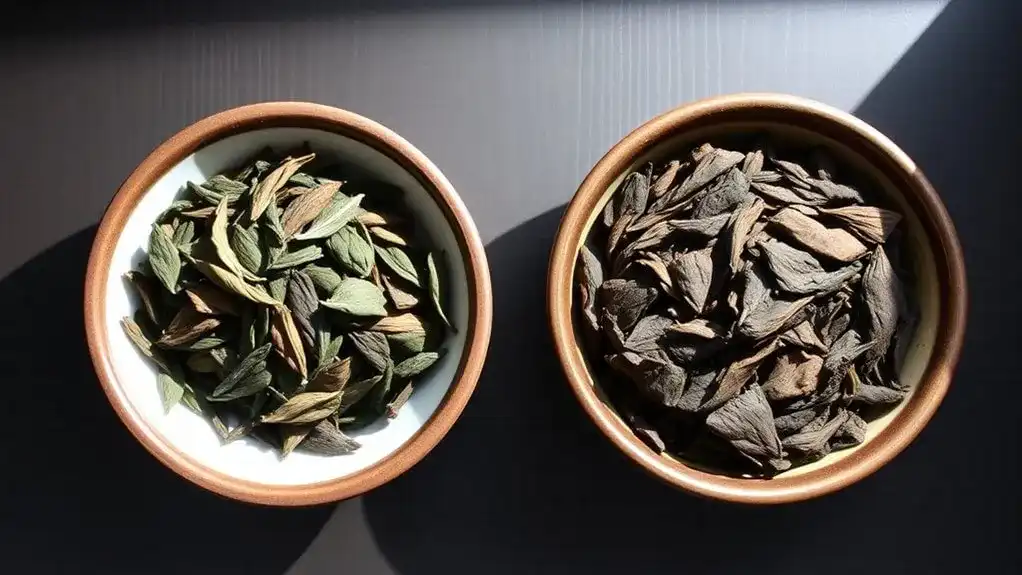
Unlike raw Pu-erh's straightforward production, ripe Pu-erh undergoes an innovative fermentation process called wo dui, which revolutionized tea production in the 1970s. This wet-piling technique creates a warm, humid environment where tea leaves are moistened, piled, and covered for 15-40 days. Sun-dried tea leaves are essential, as machine-dried leaves would lack the necessary enzymes for proper fermentation.
The wet piling benefits are significant: it accelerates aging, develops rich flavors, and produces consistently marketable tea. Initially designed to meet Hong Kong's demand, this process transformed the tea industry. Careful fermentation control is essential throughout the process. Workers spray water onto tea piles, maintain temperatures between 50-65°C, and turn the leaves every two weeks. They also furrow the piles daily during the final stages to manage moisture and heat levels. The process was first developed by the Menghai tea factory in Yunnan, China.
This controlled environment transforms the tea leaves, resulting in a deep, earthy flavor profile that mimics naturally aged raw Pu-erh, but in a fraction of the time.
Essential Differences Between Raw and Ripe Varieties
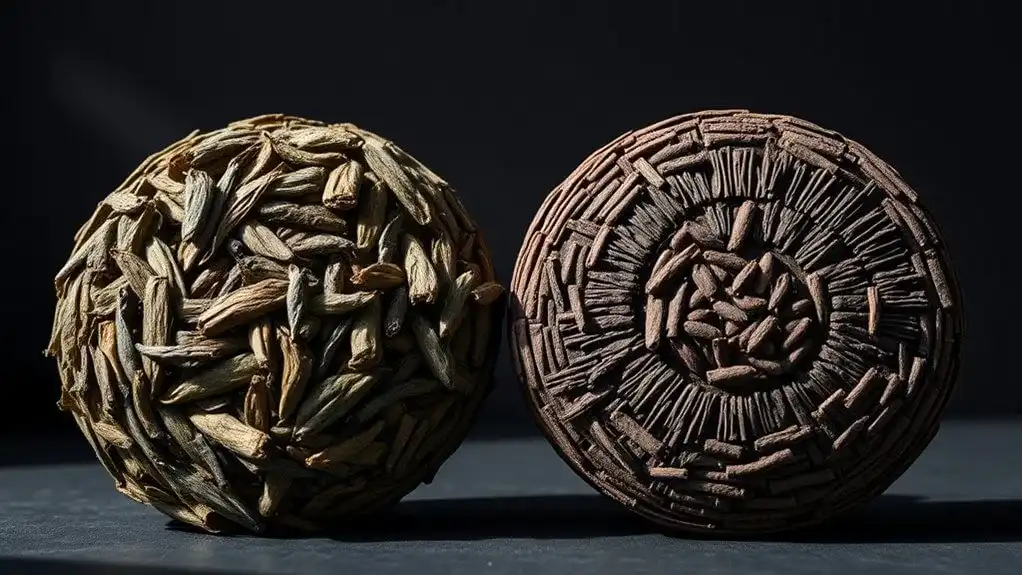
Processing methods create striking contrasts between raw and ripe Pu-erh, with each variety following distinct paths to achieve its final form. The key distinction lies in fermentation: raw Pu-erh ages naturally over time, while ripe Pu-erh undergoes controlled wet-piling to accelerate the process.
Similar to Liu Bao tea's influence in Southeast Asia, Pu-erh has become a highly valued dark tea among traditional tea enthusiasts. These approaches greatly impact flavor profiles and enzyme activity. Raw Pu-erh maintains higher enzyme levels essential for natural aging, developing sharper initial tastes that gradually mellow. Young raw Pu-erh exhibits pleasant bitterness and sweetness, creating a unique flavor experience. Traditional processing involves carefully stir-roasting by hand in iron woks to preserve essential enzymes for aging. In contrast, ripe Pu-erh's wet-piling process reduces enzyme content while creating deeper, earthier flavors through microbial fermentation. The results extend beyond taste – raw Pu-erh typically appears lighter in color and requires more careful storage conditions, whereas ripe Pu-erh exhibits darker hues and greater stability due to its completed fermentation process.
Aging and Storage Requirements
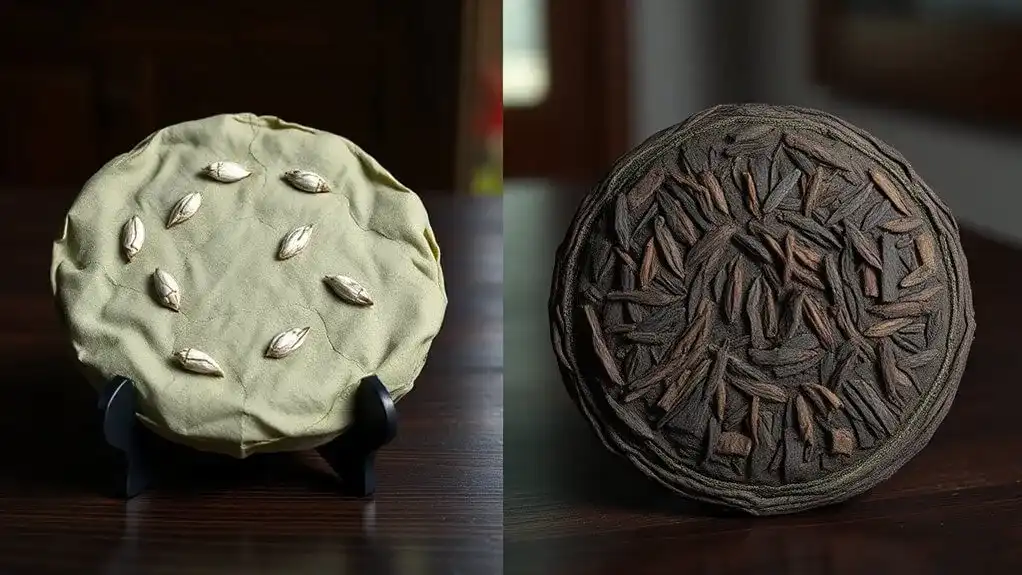
Proper storage conditions play an essential role in determining Pu-erh tea's aging potential and final quality. Both raw and ripe varieties require specific aging techniques, with temperatures between 20-30°C and humidity levels of 50-70%. Storage containers like ceramic jars, zisha pottery, and original packaging help maintain ideal conditions while protecting the tea from external odors and direct sunlight. These distinct varieties must be stored separately to prevent their unique aromas from affecting each other. Clean storage environments are crucial for preserving the integrity of Pu-erh tea. High-quality raw Pu-erh can develop complex flavors for up to sixty years when stored properly.
- The thrill of watching raw Pu-erh transform from bright and astringent to deep and complex over decades
- The satisfaction of perfectly aged ripe Pu-erh developing rich, earthy notes
- The excitement of opening a well-stored vintage tea that's gained value over time
- The pride of maintaining favorable conditions for these living teas
Raw Pu-erh ages slowly and naturally, while ripe Pu-erh undergoes accelerated fermentation through wet-piling, achieving desired characteristics in just 2-7 weeks.
Quality Assessment and Final Product Characteristics
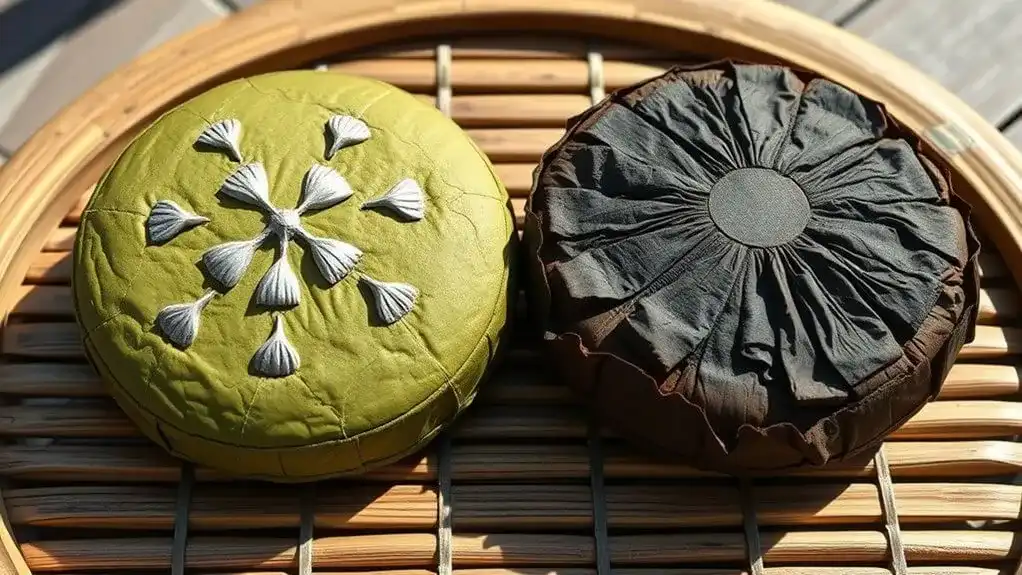
While aging conditions set the foundation for Pu-erh's development, a tea's true value emerges through careful quality assessment. Quality indicators begin with the dry tea's appearance – leaves should be whole, distinct, and free from twigs or powdery residue. High-quality pressed Pu-erh often displays a characteristic matte sheen. Both raw and ripe varieties can be compressed into various shapes and cakes. Hydraulic presses create distinctive dimpled patterns on the reverse side of compressed cakes.
The liquor of both raw and ripe Pu-erh should be clear, never cloudy or muddy. Young raw Pu-erh exhibits distinct flavor profiles featuring camphor, herbal notes, and a bitter-sweet complexity. The presence of gān (sweet aftertaste) indicates superior quality. Raw Pu-erh undergoes a natural progression where aged teas become smoother with time. Ripe Pu-erh, processed through controlled fermentation, maintains more consistency in its flavor profile. In both varieties, the tea should deliver persistent flavors across multiple infusions, while avoiding any musty or moldy characteristics that might indicate improper processing.
Conclusion
While some tea enthusiasts insist there's a "superior" choice between raw and ripe pu-erh, both varieties offer distinct experiences worth exploring. Raw pu-erh provides a journey through natural aging and complex flavor development, while ripe pu-erh delivers immediate depth and smoothness through accelerated fermentation. Understanding these differences helps tea lovers make informed choices based on their preferences, storage capabilities, and desired drinking timeline.
